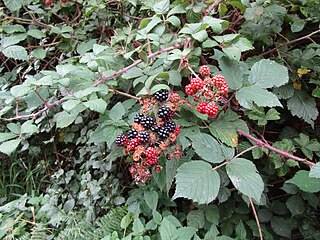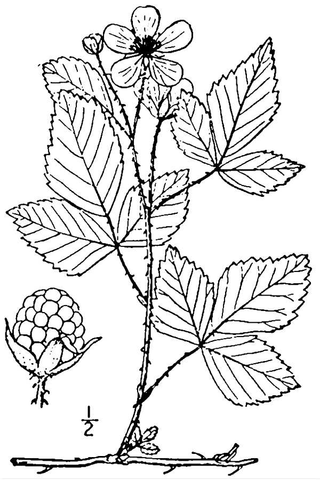
Rubus is a large and diverse genus of flowering plants in the rose family, Rosaceae, subfamily Rosoideae, with over 1,350 species, commonly known as brambles.

The dewberries are a group of species in the genus Rubus, section Rubus, closely related to the blackberries. They are small trailing brambles with aggregate fruits, reminiscent of the raspberry, but are usually purple to black instead of red. Alternatively, they are sometimes referred to as ground berries.

The loganberry is a hybrid of the North American blackberry and the European raspberry.

Rubus caesius is a Eurasian species of dewberry, known as the European dewberry. Like other dewberries, it is a species of flowering plant in the rose family, related to the blackberry and raspberry. It is widely distributed across much of Europe and Asia from Ireland and Portugal as far east as Xinjiang Province in western China. It has also become sparingly naturalized in scattered locations in Argentina, Canada, and the United States.

Rubus parviflorus, commonly called thimbleberry, is a species of Rubus native to northern temperate regions of North America. The plant has large hairy leaves and no thorns. It bears edible red fruit similar in appearance to a raspberry, but shorter, almost hemispherical. It has not been commercially developed for the retail berry market, but is cultivated for landscapes.

Rubus hispidus, with the common names swamp dewberry, bristly dewberry, bristly groundberry, groundberry, hispid swamp blackberry or running swamp blackberry, is North American species of dewberry in the rose family.

Rubus leucodermis, also called whitebark raspberry or blackcap raspberry, is a species of Rubus native to western North America.

Rubus pensilvanicus, known commonly as Pennsylvania blackberry, is a prickly bramble native to eastern and central North America from Newfoundland south to Georgia, west as far as Ontario, Minnesota, Nebraska, and Arkansas. The species is also established as a naturalized plant in California.

Rubus ursinus is a North American species of blackberry or dewberry, known by the common names California blackberry, California dewberry, Douglas berry, Pacific blackberry, Pacific dewberry and trailing blackberry.

Rubus pubescens is a herbaceous perennial widespread across much of Canada and the northern United States, from Alaska to Newfoundland, south as far as Oregon, Colorado, and West Virginia.

Smilax bona-nox, the saw greenbrier, is a species of plant in the family Smilacaceae. It is native to the Southern United States, and eastern Mexico.

Rubus flagellaris, the northern dewberry, also known as the common dewberry, is a North American species perennial subshrub species of dewberry, in the rose family. This dewberry is distributed across much of Canada, Mexico, and the United States. It grows in diverse habitats ranging from drier savannas to temperate deciduous forests.
Rubus aboriginum is a North American species of dewberry, known as the garden dewberry and aboriginal dewberry. Like other dewberries, it is a species of flowering plant in the rose family, related to the blackberry. It is native to the United States and Mexico, primarily in the southern Great Plains.

Rubus invisus is a species of dewberry, known as upland dewberry. Like other dewberries, it is a species of flowering plant in the rose family, related to the blackberry. It is found in the eastern and east-central United States.
Rubus apogaeus, the falling dewberry, is a North American species of southern dewberry in section Verotriviales of the genus Rubus, a member of the rose family. It is found in scattered locations in the southern United States.
Rubus arenicola, the sanddwelling dewberry, is an uncommon North American species of flowering plant in the rose family. It is found in eastern Canada and the northeastern United States.
Rubus deamii, known as Deam's dewberry, is a North American species of dewberry in section Procumbentes of the genus Rubus, a member of the rose family. It grows in scattered locations in the east-central United States and southern Canada, from Ontario south to Missouri, Tennessee, and West Virginia, but nowhere is it very common.
Rubus riograndis is a North American species of dewberry in section Verotriviales of the genus Rubus, a member of the rose family. It has been found only in Texas in the south-central United States.













